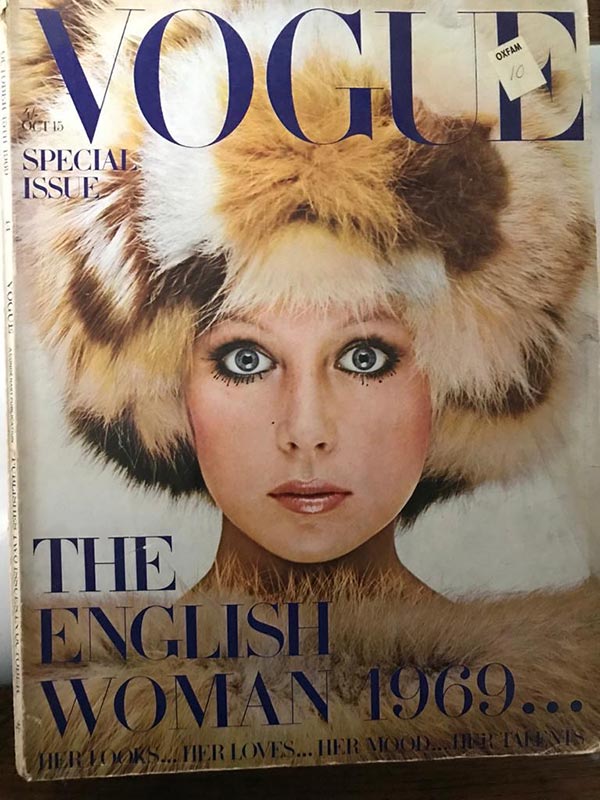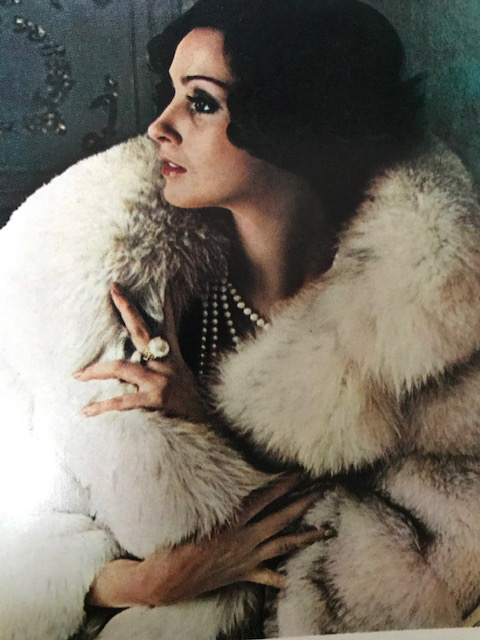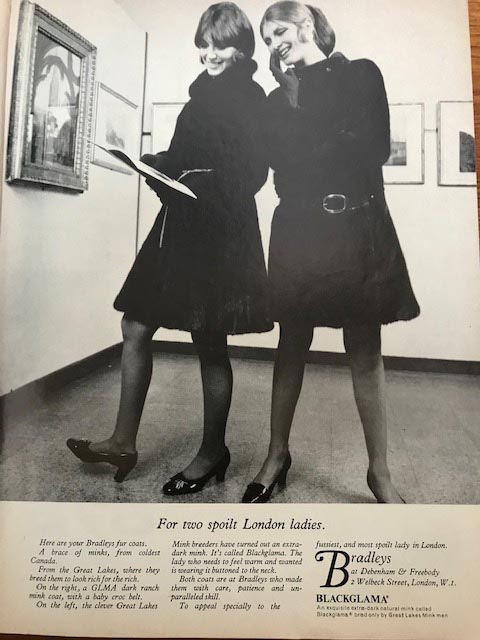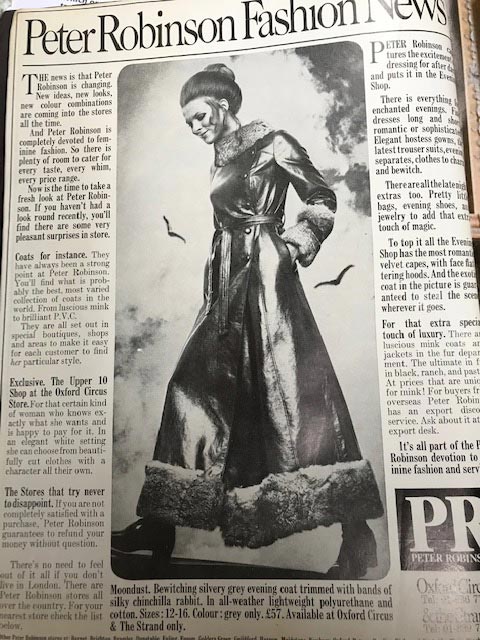Fur From The Madding Crowd
Whilst flicking through a vintage Vogue magazine recently I was struck by the number of advertisements for fur coats. “When did people start wearing fur?” is a question that is often asked. The answer is that, largely due to necessity, people wore fur around 170,000 years ago. They hunted for their food and used the skins for warmth.
To someone with today’ sensibilities this may be shocking, but at least it was done out of necessity, not frivolity or fashion. But is wearing fur ethical? This seems to depend on your point of view.
This edition of Vogue, features model Patti Boyd, wearing a multi colored fox fur hat. A fur scarf or shawl drapes across her shoulders. The photograph oozes the glamour fur represented.
In turn, the masses yearned to imitate the look, turning to cheaper, more accessible pelts, to satisfy their dreams.
During the ‘40’s 50’ and 60’s, wearing fur for no other reason than to advertise wealth and social standing was not unusual. Trophy wives, the jet set, famous actresses like Taylor and Monroe and debutantes were often photographed draped in fox, mink and exotic skins. They gave undeniable kudos to the fashion.

Today, whilst it is not ‘bad’ to wear fur, the frivolous wearing of it is mostly frowned upon. For many it is no longer considered appropriate to wear a fur coat . Having said that, the industry is still worth in excess of £40 billion annually, so there is obviously a market for it!
More than a billion animals per year are slaughtered for the fur industry, often in horrific and barbaric ways.
Animal rights movements have highlighted the many issues surrounding fur. Those wishing to make informed decisions have easy knowledge at their fingertips. Women of previous eras were not as informed and wore fur with the happiness of ignorance.
In 1962, US First Lady, Jacquline Bouvier Kennedy appeared in a Leopard skin coat designed by Oleg Cassini. This sparked a terrifying trend for wearing fur from exotic species.
Aspirations of owning a fur exploded during this era. Those unable to afford the £80,000 or more for a Sable coat, could always buy one made of rabbit fur instead, popular throughout the ‘50’s and ‘60’s as a more affordable option.
High-end magazines were quick to run advertisements promoting Leopard skin garments. Once aware of the influence her choice of coat had made, Jacqueline Kennedy stopped wearing it soon after. The sensation she had caused and the ensuing demand for leopard-skin almost drove the species to extinction. Nearly a quarter of a million leopards were killed. Tigers and other exotic species were also (literally) in the firing line for their precious skins.
Cassini, mortified at his role in the demise of these creatures and is said to have never forgiven himself.
But is it OK to wear vintage fur? Do old fur coats have any value? What can you do if you’ve inherited a fur coat?
These are all valid questions, some create a modern moral quandary. Regardless, the vintage fur market is currently booming. New markets are discovering old furs, and fashion bloggers offer tips on how to wear vintage fur.



Is Vintage Fur Acceptable?
In a 2019 article entitled “Am I The Only One Who Feels Guilty About Wearing Vintage Fur?’ Liana Satenstein interviewed a colleague – Features Editor Lilah Ramzi, who said this about her collection of vintage furs:
“I opt for vintage most of the time, so none of my furs are contemporary garments…wearing old furs promotes recycling and reduces waste in the grand scheme of things, but it also perpetuates the idea of fur as fashion.”
Lilah Ramzi
She does have a point. It is a form of recycling, and the argument about faux fur being an alternative to fur is also flawed. Manufacturing processes used to produce faux fur have real implications regarding the toxic emission and the environment.
Fur is long-lasting, functional, biodegradable, warm and comfortable to wear, so the issues surround the question of whether it is ok to wear fur seem to hinge upon your viewpoint.
The debate as to whether or not to wear fur still rages and, even though we are supposedly more informed, the fur trade is growing once more.
A huge demand in the newly affluent countries of China, Asia and Russia and the availability of cheap pelts could be to blame.
Either way, it’s the welfare of these animals that causes the most concern.
Animals earmarked for fur are kept in captivity all of their short lives, many in tiny cages. They are then executed in a variety of ways, including anal electrocution of foxes. Fur farmers claim this to be the quickest method, but the primary reason is that the fur remains unscathed.
On a lighter note, in the UK, Buckingham Palace recently revealed that HRH Queen Elizabeth ll will no longer wear real fur. From 2019, her new outfits will be embellished with faux fur instead … with the exception of historical, ceremonial robes.
However exciting this may be for those against the wearing of fur, it raises the issue of faux fur manufacture and its impact upon the environment. HRH’s popularity, as with Jackie Kennedy’s in the 60’s may cause an upsurge in demand for faux fur. Still, animal rights activists are viewing the Queen’s new stance as a victory.
The whole fur trade debate pivots upon whether you view killing animals for fur as ethical or not. Animal liberation apart, the arguments against fur seem to revolve around the issues of animal husbandry. How were the animals treated whilst they were alive?
How was it killed? Did the animals die of natural causes or were they killed humanely, would the wearing of fur then be more acceptable? If pelts were sourced from culled animals, would that be OK?


Most people in the 21st Century agree that the wearing of any fur is unacceptable and would baulk at wearing the mink pelt stoles worn by women in the 1940s and ’50s. Some items such as stoles were even worn with the head and feet intact. Accessories could also be made of fur with mink or ermine fur used as earrings!
The Endangered Species Act of 1973 was set up to protect almost 2000 species from the threat of extinction and to preserve the precious ecosystems many of them depend upon.
The fur trade, unlike many other animal based industries , are justly disgruntled at being singled out for such intense scrutiny. We may be squeamish about wearing fur, yet a lot of us are hypocritical, continuing to drink milk, eat meat and buy leather jackets, shoes or handbags. These areas far outweigh the turnover of animals slaughtered for fur.

They have not been so rigorously scrutinised, have not had to improve their workplace practices. Many fur farmers have spared no expense in the care of their animals up to and including execution. The result of this care is a superior quality pelt. But, sadly, such farmers are the exception rather than the rule.
The durability of fur cannot be disputed, it’s fashion credentials impeccable but will it last? How will new generations of women feel about fur as a fashion statement? Will they flatly reject it or embrace the advances in animal care? will continue as long as people are willing to pay the big bucks. But, as consumers become more aware of the suffering it entails, it remains to be seen whether the popularity of fur continues.